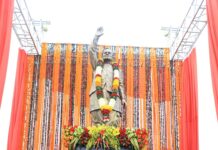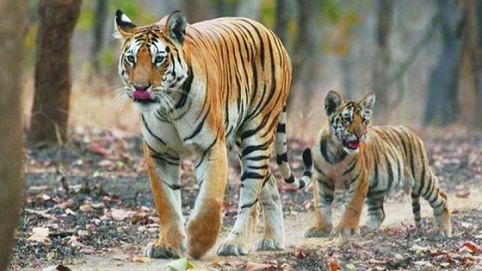By Our Correspondent
NEW DELHI/BHUBANESWAR/ANGUL: Three States including Maharashtra ruled by Shiv Sena , Chhattisgarh by Congress and Jharkhand’s JMM have already opposed Commercial Coal Mining in their States since Prime Minister Narendra Modi announced auction of 41 Blocks on June 18. Out of the total 41, 10 Coal Mines Blocks put for Auction in Odisha.
The mines are Chendipada I, Chendipada II, Machhakata, Mahanadi, Radhikapur (East), Radhikapur (West), Brahmanbil & Kardabahal, Kuraloi (A) North, and Phuljhari (East & West). Private players like Rungta Mines Limited, Jindal Steel and Power Ltd, JSW Steel-Energy, Essel Mining and Industries Ltd, Hindalco, Tatas, Sesa Goa, Vedanta Industries Ltd, Adani Group, Thriveni Earth Movers Pvt Ltd and global players like Rio Tinto, BHP Billiton, PesBody, Glencore and Vale are among those eyeing on Odisha’s Coal blocks.
Most of these Blocks belongs Angul-Talcher coal Belt, close to Satkosia and Similipal Tiger Reserves. Satkosia spreads along the magnificent gorge over the mighty river Mahanadi in Odisha. Established in 1976 as a wildlife sanctuary, Satkosia is a paradise of immense scenic charm. It is one of the best ecosystems in the country, representing a diverse floral and faunal extravaganza. The Reserve is spread over 4 districts like; Angul, Cuttack, Nayagarh and Boudh. The reserve has an area of 963.87sq km with 523.61sq km as core area. The area is also a part of the Mahanadi elephant reserve. Satkosia is the meeting point of two bio-geographic regions of India; the Deccan Peninsula and the Eastern Ghats, contributing immense biodiversity.
Importantly, the National Tiger Conservation Authority has identified a potential link for the migration of wild animals from the Similipal Tiger Reserve to the Satkosia Tiger Reserve and has proposed a corridor. It is a very long corridor, but is highly fragmented due to intense mining activities, power stations and a large number of human habitations. According to a study by the Wildlife Institute of India, Dehradun, conducted in 2014, there are more than 250 villages in and around of this corridor.
A part of this proposed corridor connects the Similipal National Park with the Hadgarh Wild-life Sanctuary through the Noto and Satkosia Reserve Forests. The other corridor considered to be important for the movement of the animals is the BaulaKuldiha corridor, which is 15-16 km long. This corridor connects the Kuldiha Wild-life Sanctuary with the Hadgarh Wildlife Sanctuary through small hillocks in the Garsahi Reserve Forest, Gaguapahar, Balihudi and Baula hills. This corridor is being used by herds of 20-25 elephants. The Hadgarh-Kuldiha corridor is also being used by small herds of 10-15 elephants.
Thus a connection between the Similipal Tiger Reserve, the Hadgarh Wildlife Sanctuary and the Kuldiha Wildlife Sanctuary forms a U-shaped path that provides a potential movement corridor to tigers and elephants. The movement of elephants has also been observed from Kuldiha to the Satkosia Tiger Reserve. The complete length of the proposed Similipal–Satkosia corridor may not be effectively functional due to several anthropogenic pressures, but from a conservation point of view, it is very important.
The name Satkosia originates from two words; sat meaning seven and kos meaning two miles, indicating the length of the gorge as 14 miles or 22 km. The area was declared as Satkosia Tiger Reserve in 2007, comprising two adjoining wildlife sanctuaries; the Satkosia Gorge sanctuary and Baisipalli sanctuary.
Of the 10 blocks picked from Odisha, only one, Phuljhari East and West, had been classified as no-go. The has not red-flagged this auction yet as most of its no-go blocks have not been included. In a nutshell, experts say it can be concluded that environmental concerns have not been addressed while finalising the list of the coal blocks.
The list of total 41 coal blocks up for auction includes 14 which had been classified as ‘no-go’ in 2010 because of their dense forest cover and environmental value. The study was not approved as a rule in 2012 on the pretext that classification on more scientific and objective parameters to identify inviolate forest areas would be done. The said classification on the six parameters which were suggested in 2012 is still pending.
The government had asked the Forest Survey of India to suggest inviolate forest areas among coal blocks and the first list was submitted in August 2014. But the ministry of coal had been continuously seeking more and more coal blocks out of the inviolate list.The exercise is being done without putting any information in the public domain which is contrary to the report of the committee that has suggested violate and inviolate classification. Still there are 14 coal blocks earlier classified as no-go and 8 coal blocks in the present auction list which have been classified as inviolate by the FSI.
Due to deforestation in various hills, 80 per cent of streams have gone dry in Odisha’s mineral rich Keonjhar-Sundargarh-Mayurbhanj and Jajpur . The water flow in Deogarha’s Padhanpata , Sundargarh’s Khandadhar and Keonjhar’s Sanaghagara and Badaghagara waterfalls has decreased by 50 per cent in last 12 years. Locals in Coal rich areas like Sundargarh, Jharsuguda, Angul, Talcher, Sambalpur and Dhenkanal are apprehending ecology hardship.
The Naveen Patnaik led Government in Odisha had earlier admitted that the water-flow in the Padhanpata waterfall at Deogarh had decreased drastically due to destruction of forests. Locals in Coal and mineral rich areas however expressed concerns over the dwindling of the wild animals and the increasing man-animal conflict in human habitations due to water and fodder scarcity in jungles and hills in view of large scale mining.
For the Satkosia Tiger Reserve, Similipal is considered to be the source population of tigers because of seclusion of Satkosia from other connected protected areas. Conservationists hope that the proposed corridor will help recover tiger populations in the Satkosia Tiger Reserve in the near future. Commercial Coal Mining will pose a threat to the abundance and diversity of flora and fauna and would further worsen the connectivity. From an ecological perspective, the cumulative impacts of mining in this region will further aggravate the sustainability challenges of the landscape due to disturbances, deterioration of forest ecology and alteration in drainage system.
At present, tiger densities in both Similipal and Satkosia are depressed and there is a lack of a source population to ensure tiger occupancy within the larger landscape. With appropriate protection and managerial changes, tiger populations in both these reserves can revive, but their long-term survival would depend on the gene flow between these populations. Therefore, multi-layered strategies will be required to keep this corridor functional. At the same time, there is an urgent need for an assessment of the impact of mining on the wild flora and fauna before clearance is given for further extension of the lease for mining.
Odisha , which houses 79,295 Million ton of coal deposits, is the second most Coal bearing State in the Country while India is the 5th biggest coal bearing Nation in the World. In past, Odisha Government only auctioned 1 coal block-Jamkhani, which had won by Anil Agarwal’s Vedanta Limited. Odisha has hiked it coal production by 23 % in last 5 years, while National Coal Production increased by 24 %. India’s coal production was 730.54 Million ton during 2018-19 with a growth of 7.9 %.






























